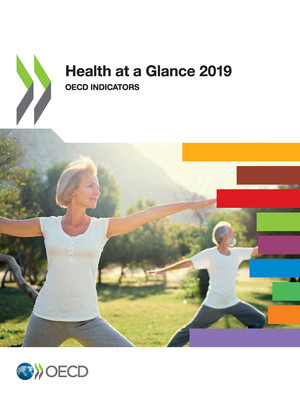copy the linklink copied!Foreword
Health at a Glance compares key indicators for population health and health system performance across OECD members, candidate and partner countries. This 2019 edition presents the latest comparable data across 80 indicators, reflecting differences across countries in health status, risk factors and health-seeking behaviour, access, quality of care, and the financial and physical resources available for health. Alongside indicator-by-indicator analysis, an overview chapter summarises the comparative performance of countries and major trends, including how much health spending is associated with staffing levels, access, quality, and health outcomes. This edition also includes a special chapter on patient-reported outcomes and experiences.
The production of Health at a Glance would not have been possible without the contribution of national data correspondents from OECD countries. The OECD gratefully acknowledges their effort in supplying most of the data contained in this publication, as well as their detailed feedback to a draft of the report. Special acknowledgement is extended to members of the Patient-reported Indicator Surveys (PaRIS) Working Groups on mental health, breast cancer care, and hip and knee replacement for their contribution to Chapter 2, especially those individuals from countries, registries and health care organisations that facilitated the provision of patient-reported data. The OECD also recognises the contribution of other international organisations, notably the World Health Organization and Eurostat, for providing data and comments. The European Union provided financial and substantive assistance for work related to PaRIS, but the opinions expressed and arguments employed herein do not necessarily reflect the official views of the OECD member countries or the European Union.
This publication was prepared by the OECD Health Division under the coordination of Chris James. Chapter 1 was prepared by Chris James and Alberto Marino; Chapter 2 by Luke Slawomirski, Ian Brownwood, Emily Hewlett and Rie Fujisawa; Chapter 3 by Chris James, Viviane Azaïs, Eileen Rocard, Yuka Nishina and Emily Hewlett; Chapter 4 by Cristian Herrera, Jane Cheatley, Gabriel Di Paolantonio, Yuka Nishina and Michael Padget; Chapter 5 by Chris James, Michael Mueller, Viviane Azaïs, Alberto Marino and Marie-Clémence Canaud; Chapter 6 by Frédéric Daniel, Michael Padget, Eliana Barrenho, Rie Fujisawa, Luke Slawomirski and Ian Brownwood; Chapter 7 by David Morgan, Michael Mueller, Emily Bourke, Luca Lorenzoni, Alberto Marino and Chris James; Chapter 8 by Karolina Socha-Dietrich, Gaëlle Balestat, Gabriel Di Paolantonio, Emily Bourke and Emily Hewlett; Chapter 9 by Chris James, Gabriel Di Paolantonio, Gaëlle Balestat, Alberto Marino and Caroline Penn; Chapter 10 by Valérie Paris, Ruth Lopert, Suzannah Chapman, Martin Wenzl, Marie-Clémence Canaud and Michael Mueller; Chapter 11 by Elina Suzuki, Leila Pellet, Marie-Clémence Canaud, Thomas Rapp, Eliana Barrenho, Michael Padget, Frédéric Daniel, Gabriel Di Paolantonio, Michael Mueller and Tiago Cravo Oliveira Hashiguchi. The OECD databases used in this publication are managed by Gaëlle Balestat, Emily Bourke, Ian Brownwood, Marie-Clémence Canaud, Frédéric Daniel, David Morgan, Michael Mueller and Michael Padget.
Detailed comments were provided by Frederico Guanais and Gaétan Lafortune, with further useful inputs from Francesca Colombo, Mark Pearson, Stefano Scarpetta and Sarah Thomson. Editorial assistance by Lucy Hulett, Lydia Wanstall and Marie-Clémence Canaud is also gratefully acknowledged.


